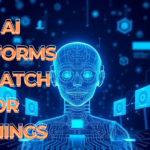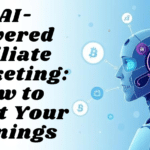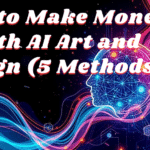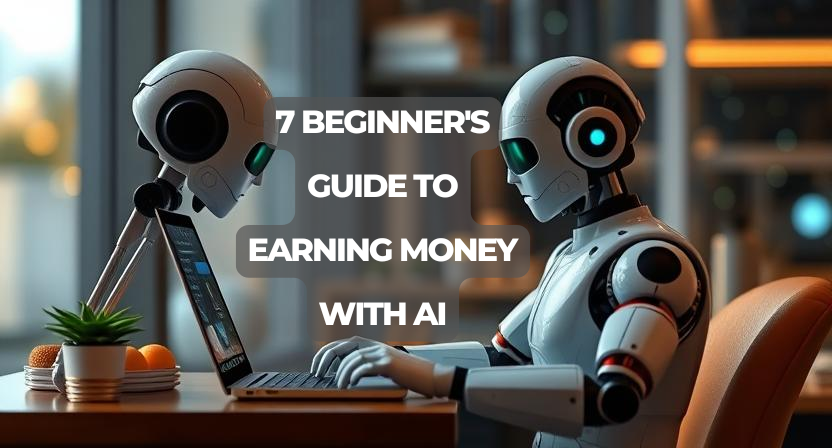AI Tools to Make Money
Artificial intelligence has become a game-changer across industries, offering innovative solutions that simplify tasks and open doors to new income opportunities. AI tools to make money are inevitable. With advancements like generative AI and ChatGPT, businesses and individuals can now automate repetitive tasks, develop product designs, and even create software code with ease. These technologies are not just futuristic ideas but are already transforming how we approach work and revenue generation.
10 Best AI Money Earning Methods That We Should Know
For instance, in digital marketing, AI optimizes campaigns to reach the right audience, while in software development, AI accelerates time-to-market for new products. This shift is making it easier for people to explore new ways to earn, whether through freelance writing, app development, or even photo editing. The best part? The cost of integrating these AI-driven solutions is relatively low compared to the potential income they can generate.
By embracing these technologies, businesses can boost efficiency and scalability, setting the stage for a more profitable future. Whether you’re a freelancer or a business owner, AI is no longer just a trend—it’s a powerful tool that’s here to stay.
Understanding the Role of AI in Modern Business
In today’s fast-paced world, businesses are constantly seeking innovative ways to stay ahead. Artificial intelligence (AI) has emerged as a powerful solution, revolutionizing how companies operate and interact with customers. But what exactly is AI, and how does it shape modern industries?
Defining Artificial Intelligence
At its core, AI refers to systems designed to simulate human intelligence. These systems can learn, reason, and solve problems like humans. Subsets of AI include natural language processing (NLP) and machine learning, which enable applications like chatbots and predictive analytics.
How AI Shapes Today’s Industries
AI is transforming industries from finance to retail. For instance, customer service has seen a significant boost with AI-powered chatbots, reducing response times and improving user experiences. In marketing, AI helps businesses make smarter decisions by analyzing vast amounts of data, leading to more efficient campaigns and higher ROI.
According to recent market trends, nearly 90% of business leaders plan to increase their investment in AI. This growth is driven by the technology’s ability to enhance operational efficiency and customer satisfaction. As AI continues to evolve, its role in shaping modern business strategies will only expand.
Foundations of AI: Key Concepts and Technologies
At the heart of every AI innovation lies a set of foundational technologies that drive these advancements. Understanding these core concepts is essential for harnessing their potential in various industries.
50 High-Paying Technology-Related Keywords for Google AdSense
Natural Language Processing and Chatbots
Natural Language Processing (NLP) is a cornerstone of AI, enabling machines to understand and generate human language. This technology powers chatbots, which automate conversations and significantly reduce customer service workloads. By analyzing vast amounts of data, NLP creates customer-centric experiences, positively impacting customer sentiment and satisfaction.
Machine Learning and Deep Learning
Machine learning and deep learning are pivotal in recognizing patterns and making decisions. While machine learning focuses on algorithms that learn from data, deep learning uses neural networks to mimic human brain functions. Both are crucial for predictive analytics and decision-making, though their effectiveness depends heavily on the quality of the data they’re trained on.
Computer Vision Applications
Computer vision allows machines to interpret visual data, enhancing fields like medical imaging and security. However, it’s important to note that systems can be deceived by visual illusions or lighting, highlighting their real limitations.

These technologies form the backbone of AI’s transformative power across industries, from marketing and content creation to service enhancements. By leveraging these foundational elements, businesses can unlock new opportunities and drive innovation.
Identifying Income Opportunities with AI-Driven Tools
In today’s evolving digital landscape, AI-driven solutions are unlocking fresh avenues for earning. These innovations are not just limited to big businesses; they offer ample opportunities for individuals and small enterprises to explore new revenue streams.
Niche Markets and Innovative Ideas
Niche markets often present untapped potential. For instance, AI-driven design platforms simplify graphic design, enabling freelancers to offer services on platforms like Fiverr. Similarly, content generators can boost website engagement, helping bloggers attract more visitors and increase their organic traffic by up to 40%.

Consumers and businesses alike are seeking product solutions that save time and enhance productivity. Real-life examples include AI-powered medical assistants addressing healthcare access issues and AI-driven video production tools that simplify content creation for YouTubers, potentially increasing viewer engagement by 50%.
Spotting Market Gaps and Monetizing Innovations
To efficiently monetize AI-driven innovations, it’s crucial to identify market gaps. For example, AI can be used for predictive analytics, offering a significant return on investment. By leveraging these technologies, businesses can create innovative product solutions that meet specific needs, driving growth and profitability in their respective niches.
AI tools to make money: Strategies for Digital Success
Embracing artificial intelligence can transform your business, opening new avenues for growth and efficiency. By integrating AI, you can streamline operations and uncover fresh revenue streams.
Implementing AI-Powered Business Models
Starting with AI involves clear strategic planning. Identify areas where automation can simplify tasks, then choose the right AI solutions. For instance, AI can optimize marketing campaigns or enhance customer service, leading to cost savings and improved efficiency.
How to Make Money with AI Art and Design (8 Methods)
Businesses that adopt AI often see a significant reduction in manual tasks. This shift allows teams to focus on strategic initiatives, driving innovation and growth. Plus, AI can improve decision-making by analyzing large datasets, uncovering insights that might be missed manually.
Real-World Success Stories
Many companies have successfully harnessed AI to boost revenue. For example, an e-commerce firm used AI to personalize recommendations, increasing sales by 20%. Another business automated its lead generation, cutting costs by 30% and boosting efficiency.

These examples show how AI can be a powerful tool for business transformation. By following a strategic approach and learning from others, you can unlock new opportunities and achieve your goals in the digital age.
Leveraging AI in Software Development and Data Analytics
From coding assistants to advanced analytics, AI is reshaping how we approach software development and data interpretation. This transformation not only speeds up processes but also enhances precision and decision-making capabilities.
Accelerating Coding with AI Assistants
AI-powered tools like GitHub Copilot are revolutionizing software development. These platforms offer intelligent code suggestions, reducing errors by up to 50% and boosting coding speed by 30%. Such advancements allow developers to focus on complex problem-solving rather than repetitive tasks.

Automated code reviews further improve efficiency, identifying 90% of potential issues before deployment. This not only cuts debugging time but also ensures higher code quality, making AI an indispensable ally for developers.
Turning Data into Decisions
Data analytics is another area where AI excels. Tools like DataRobot transform raw data into actionable insights, enabling smarter business decisions. Predictive analytics improves forecasting accuracy by 20-30%, while real-time data processing allows for quicker decision-making.
AI reduces human bias in decision-making by 30%, relying on data-driven analysis. This shift towards AI-enhanced platforms not only streamlines operations but also fosters innovation, driving businesses toward a more efficient and profitable future.
Enhancing Digital Marketing Through AI
Digital marketing is undergoing a significant transformation thanks to advancements in artificial intelligence. This technology is reshaping how businesses approach their marketing strategies, making them more efficient and targeted.
Optimizing Paid Advertising Campaigns
AI plays a crucial role in refining paid advertising campaigns. By analyzing vast amounts of data, AI can identify the most effective ad placements and audiences, leading to better ROI. For instance, predictive analytics helps in fine-tuning campaigns, ensuring that your ads reach the right people at the right time. This level of precision can significantly boost your campaign’s performance and overall effectiveness.
Automating Content and Social Media Strategies
Another key area where AI excels is in automating content creation and social media management. Tools powered by AI can generate compelling content and schedule posts, maintaining a consistent online presence. For example, chatbots can engage with customers on social media, providing instant responses and improving customer satisfaction. These chatbots operate round the clock, ensuring that no customer inquiry goes unanswered.

Moreover, AI-driven platforms like Mailchimp automate email marketing and provide insights into audience behavior, helping businesses refine their strategies. By leveraging these technologies, marketers can focus more on creative aspects while leaving repetitive tasks to automation. This not only saves time but also enhances the overall quality of marketing efforts.
Streamlining Customer Service with AI Chatbots – AI Tools to Make Money
Imagine having a customer support team that’s always available, never takes breaks, and can handle multiple inquiries at once. This isn’t a fantasy—it’s the reality that AI chatbots bring to businesses today. These intelligent systems are transforming how companies interact with their customers, making support faster, more efficient, and more personalized than ever before.
Efficiencies in Customer Support
AI chatbots are designed to handle large volumes of customer inquiries efficiently. By automating routine tasks like answering frequent questions or helping with basic issues, these systems free up human staff to focus on more complex problems. This not only saves time but also reduces operational costs significantly. For example, companies using advanced chatbots have reported cutting their customer service expenses by up to 30%.
| Aspect | Traditional Support | AI-Enhanced Support |
|---|---|---|
| Response Time | Often delayed, especially during peak times | Instant responses, 24/7 availability |
| Cost | High, due to staffing needs | Lower, with reduced manpower required |
| Customer Satisfaction | Can vary based on agent availability | Consistently high, with personalized interactions |
One of the key advantages of AI chatbots is their ability to learn and improve over time. Powered by machine learning, these systems analyze interactions and refine their responses to better meet customer needs. For instance, a chatbot might learn to recognize common issues and provide more accurate solutions as it processes more data.

Setting up and optimizing chatbots isn’t just about installing software; it’s about understanding your customer base and tailoring the experience to their needs. By analyzing data and feedback, businesses can fine-tune their chatbots to provide more personalized and effective support. This approach not only boosts customer satisfaction but also drives long-term loyalty and growth in the market.
Boosting Efficiency in Content Creation Using AI Technologies
Content creation has evolved significantly with the integration of AI, offering unprecedented efficiency and creativity. This section explores how AI-powered tools are revolutionizing writing, editing, and scaling content across blogs and social media.
AI-Powered Writing and Editing
AI tools like Jasper AI and ChatGPT are transforming the content creation process. These platforms streamline tasks from ideation to publication, reducing time and enhancing quality. By automating routine tasks, creators can focus on strategic and creative aspects, leading to more engaging and optimized content.
Scaling Blog and Social Media Content
AI-driven solutions enable efficient scaling of content. Whether it’s crafting blog posts or managing social media, AI tools generate high-quality drafts quickly, ensuring consistent output. This allows businesses to maintain a strong online presence without compromising on quality or creativity.

By balancing human insight with AI-generated drafts, content creators can elevate their work. Staying current with trends and leveraging AI’s capabilities enhances creative processes, ensuring content remains relevant and impactful. Effective strategies combining AI automation with human creativity are key to successful content creation in today’s digital landscape.
Creating and Monetizing AI-Powered Websites – AI Tools to Make Money
Building a website that stands out today requires more than just design skills. With AI-powered website builders like Wix and CodeWP, you can create visually stunning sites that are also optimized for search engines. These platforms use AI to analyze your content and suggest improvements in real-time, helping you climb the search engine rankings without needing an SEO expert.
Website Builders and SEO Optimization
Modern AI-powered website builders go beyond just design. They analyze your content and offer tailored SEO recommendations. For example, they might suggest keywords to include or how to structure your headings for better visibility. This real-time analysis ensures your site is always optimized, giving you a better chance of attracting organic traffic and boosting your revenue.
When it comes to making money from your website, the opportunities are vast. You can place ads, partner with affiliate programs, or even set up an online store. Video content is particularly effective, as it keeps visitors engaged longer, which can improve your site’s performance in search results. In fact, websites with video content often see a significant increase in user engagement and, consequently, revenue.

By combining AI-driven design with smart monetization strategies, you can turn your website into a profitable venture. Whether you’re showcasing products, sharing knowledge, or offering services, AI-powered tools help you build a site that not only looks great but also drives real results. Embrace these technologies, and you’ll unlock new opportunities to grow your online presence and income.
Innovative AI Applications in E-Commerce
E-commerce is experiencing a revolution, thanks to AI’s ability to create personalized shopping experiences and streamline operations. This transformation is making online stores more efficient and customer-focused than ever before.
Personalization and Targeted Marketing
AI excels at understanding customer preferences, allowing businesses to send highly targeted email campaigns. For instance, personalized product recommendations can boost sales by up to 30%. Companies like Amazon and Netflix have already seen success with this approach, significantly increasing customer satisfaction and loyalty.
Inventory Management with Predictive Analytics
AI-powered predictive analytics is a game-changer for inventory management. By analyzing sales data and market trends, businesses can anticipate demand and avoid stockouts. This not only reduces costs but also ensures products are available when customers want them, improving the overall shopping experience.
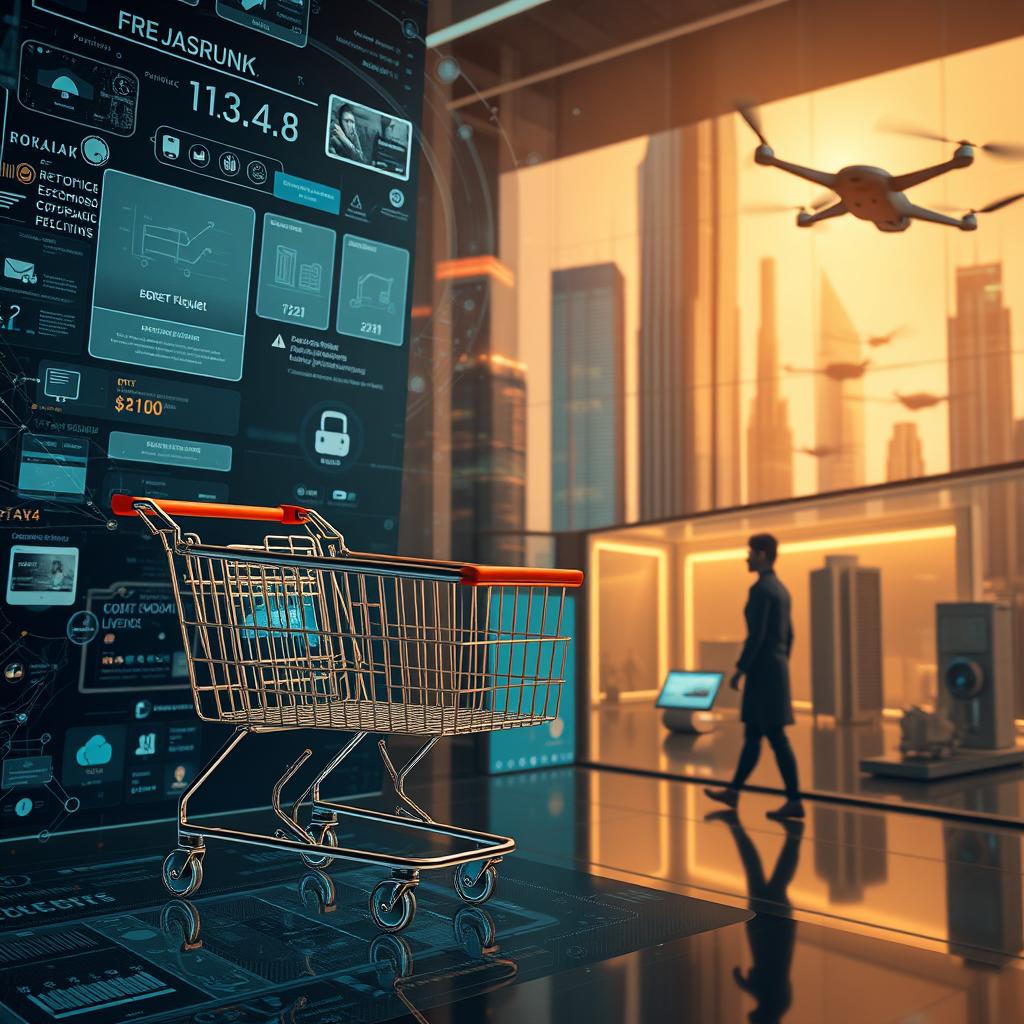
According to industry reports, AI adoption in e-commerce has led to a 20-30% increase in conversion rates. This growth highlights the effectiveness of AI in enhancing both customer satisfaction and operational efficiency. As the e-commerce industry continues to evolve, integrating AI tools will be crucial for staying competitive and meeting customer expectations.
Expanding Revenue Streams with AI in Social Media
As social media continues to dominate how businesses connect with their audiences, integrating advanced technologies has become essential for maximizing revenue. One such innovation is the strategic use of AI, which is transforming how companies engage with their audience and manage their online presence.
Targeted Advertising and Engagement
AI excels at analyzing vast amounts of data to identify specific audience segments. This capability allows businesses to create highly targeted ad campaigns that resonate more deeply with their intended audience. For example, AI can predict which demographics are most likely to engage with a particular product, leading to higher conversion rates and a better return on investment. Companies like Coca-Cola and Nike have seen significant success by using AI to tailor their campaigns, resulting in increased brand loyalty and revenue growth.
Content Curation and Scheduling
Managing a consistent and engaging social media presence can be time-consuming, but AI-driven tools simplify this process. Automated platforms can curate relevant content, schedule posts, and even analyze engagement metrics to optimize timing. For instance, a company might use AI to identify the best times to post or to suggest content that aligns with current trends. This not only saves time but also ensures a consistent and engaging online presence, which is crucial for attracting and retaining followers.

Real-world examples illustrate the power of AI in social media. For instance, a fashion retailer used AI to analyze customer preferences and tailor its content, leading to a 25% increase in sales. Similarly, a tech startup leveraged AI to automate its social media strategy, reducing costs by 30% while boosting engagement by 50%. These examples demonstrate how AI can be a powerful tool for expanding revenue streams in the digital age.
By combining creative content with data-driven targeting, businesses can unlock new opportunities for growth. Whether it’s through targeted ads or automated content management, AI offers a pathway to increased efficiency and profitability in social media. Embracing these technologies can help companies stay ahead in a competitive landscape and achieve their revenue goals.
Exploring AI for Video and Graphic Design
Design and creativity are being redefined by AI, offering fresh opportunities for both professionals and newcomers. With platforms like Midjourney, DALL-E, and Adobe Sensei, the process of creating stunning visuals has become more efficient and accessible than ever.
Automated Video Editing Techniques
AI has transformed video editing by automating tasks that once required hours of manual work. Tools like Runway and Descript can automatically add captions, remove background noise, and even adjust video clips to fit different formats. This means creators can produce high-quality videos faster, focusing more on creativity and less on technicalities.

These advancements are particularly beneficial for small businesses and freelancers. By streamlining the editing process, they can produce professional-grade content without needing a large team or expensive equipment.
Creating Stunning Visual Content
Graphic design has also seen a significant boost with AI. Platforms like Canva and DALL·E enable users to create impressive visuals even without advanced design skills. Whether it’s crafting social media posts or designing product mockups, AI-driven tools make it easier to produce eye-catching content.
Companies are leveraging these tools to create personalized marketing materials that resonate deeply with their audiences. For instance, AI can analyze customer preferences and generate tailored visuals, leading to higher engagement and conversion rates.
By combining traditional design skills with AI intelligence, creators can achieve a superior creative experience. This collaboration not only enhances the quality of the designs but also accelerates the production process, making it a win-win for both businesses and individuals.
Enhancing AI-driven Services in Translation and Localization
Global expansion is a key goal for many businesses, and language barriers often stand in the way. AI-driven translation services are breaking down these barriers, enabling companies to communicate effectively across borders. These tools not only translate languages but also consider cultural nuances, ensuring messages are conveyed accurately.
Breaking Language Barriers with AI
AI translation tools powered by large language models help businesses expand globally by ensuring accurate and culturally tuned translations. For instance, platforms like Google Translate and Microsoft Translator have set industry standards, offering real-time translations that facilitate communication. These tools are especially useful for localizing marketing materials and product information, ensuring consistency and relevance across different regions.
One of the significant advantages of AI in translation is the reduction in manual tasks. Automated tools can handle up to 90% of translation workflows, significantly improving efficiency. This not only speeds up the process but also reduces costs, making it more accessible for businesses of all sizes. For example, Neural Machine Translation (NMT) can produce translations of up to 350% higher quality compared to traditional models, ensuring that the output is both accurate and contextually appropriate.

Moreover, AI-driven solutions improve turnaround times, allowing businesses to publish content 52% faster. This is particularly beneficial for companies looking to expand into new markets, as timely and accurate translations are crucial for maintaining brand consistency. Custom MT engines trained on specific company language can output more accurate translations due to tailored training data, further enhancing the quality of the output.
Real-world examples illustrate the power of AI in translation. For instance, a fashion retailer used AI to analyze customer preferences and tailor its content, leading to a 25% increase in sales. Similarly, a tech startup leveraged AI to automate its social media strategy, reducing costs by 30% while boosting engagement by 50%. These examples demonstrate how AI can be a powerful tool for expanding revenue streams in the digital age.
| Aspect | Traditional Translation | AI-Enhanced Translation |
|---|---|---|
| Speed | Time-intensive due to manual efforts | Processes translations at speeds of up to 200 m/s |
| Cost | High, especially for large-scale tasks | Cost-effective for repetitive and large-scale tasks |
| Consistency | May lack consistency across multiple translators | Maintains consistency in terminology and style |
By combining human oversight with AI-driven translation tools, businesses can achieve a superior creative experience. This collaboration not only enhances the quality of the designs but also accelerates the production process, making it a win-win for both businesses and individuals. As AI continues to evolve, its role in shaping modern business strategies will only expand, driving innovation and profitability in the process.
Overcoming Challenges and Risks in AI Implementation
While AI offers exciting opportunities, it also brings its own set of challenges that businesses must address. Implementing AI is not without risks, and understanding these potential pitfalls is crucial for a smooth transition.
One of the primary concerns is algorithmic bias. AI systems can perpetuate biases present in their training data, leading to unfair outcomes. For instance, hiring tools might unintentionally favor certain groups, raising ethical issues. Ensuring diverse and representative data is essential to mitigate this risk.

Data privacy is another significant challenge. As AI systems process vast amounts of information, protecting sensitive data becomes critical. Businesses must comply with regulations like GDPR to avoid hefty fines and maintain customer trust.
| Aspect | Traditional Support | AI-Enhanced Support |
|---|---|---|
| Response Time | Often delayed, especially during peak times | Instant responses, 24/7 availability |
| Cost | High, due to staffing needs | Lower, with reduced manpower required |
| Customer Satisfaction | Can vary based on agent availability | Consistently high, with personalized interactions |
Another hurdle is the need for expert management. AI systems require skilled professionals to monitor and adjust their operations. Without proper oversight, businesses risk implementing ineffective solutions.
Finally, integrating AI into existing processes can be tricky. It often requires updates to infrastructure and employee training, which can be time-consuming and costly. However, with careful planning and continuous monitoring, businesses can navigate these challenges and unlock AI’s full potential.
Integrating AI for Cutting-Edge Business Transformation
The future of business is rapidly evolving, and AI stands at the forefront of this transformation. As industries embrace innovation, the integration of AI into core operations is becoming essential for staying competitive. With the rise of generative AI and platforms like ChatGPT, companies are unlocking new potential for growth and efficiency.
Future Trends and Market Shifts
The AI market is projected to grow rapidly, with businesses increasingly adopting AI to streamline operations. Over 73% of U.S. companies have already integrated AI into their operations, driven by the potential for significant returns—organizations are seeing an average of $3.70 for every $1 invested in generative AI. This growth is fueled by the ability of AI to enhance decision-making, optimize resources, and improve customer experiences.

Adapting to the Evolving AI Landscape
To thrive in this new era, businesses must stay ahead of technological advancements. Staying updated with the latest AI developments and continuously refining management strategies are crucial. Platforms like ChatGPT are paving the way for next-generation business models, offering insights and automating tasks that were once time-consuming.
| Aspect | Traditional Approach | AI-Enhanced Approach |
|---|---|---|
| Efficiency | Manual, time-intensive processes | Automated, real-time optimization |
| Decision-Making | Based on limited data analysis | Data-driven with predictive analytics |
| Customer Experience | Standardized, less personalized | Personalized, real-time interactions |
By leveraging AI, businesses can achieve superior efficiency and customer satisfaction, driving long-term growth and profitability in an ever-changing market landscape.
Final Reflections on AI and Unlocking New Income Streams
As I reflect on the journey through AI’s transformative impact, it’s clear that this technology has redefined how we approach work and creativity. From automating tasks to unlocking new income streams, AI has proven to be a powerful ally for businesses and individuals alike.
One of the most significant lessons is the importance of continuous learning. Staying updated with the latest AI tools and strategies is crucial for maintaining a competitive edge. Whether it’s enhancing customer service or streamlining content creation, adaptability is key to maximizing AI’s potential.
The opportunities AI presents are vast and varied. Freelancers can leverage AI to streamline their workflows, while established businesses can use it to innovate and expand their offerings. The ability to generate high-quality content quickly, for instance, has opened new avenues for bloggers and content creators to attract larger audiences and increase their earnings.
Reflecting on my own journey, AI has been a game-changer. It has not only streamlined my work but also enhanced my creativity. Tools like ChatGPT and Jasper AI have transformed how I approach writing, allowing me to produce engaging content efficiently. This shift has been both empowering and inspiring, showing me the limitless possibilities AI offers.
As we move forward, embracing AI isn’t just about adopting a new technology—it’s about unlocking a mindset that values innovation and continuous growth. Whether you’re a business owner or a freelancer, AI provides the tools to explore new opportunities and achieve your goals in an ever-evolving digital landscape.



